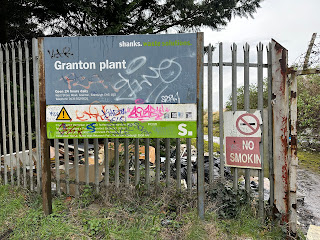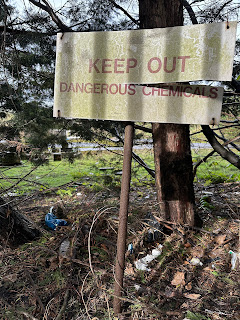Oh, I do like to find a nice bit of wasteland to wander around. A place of concrete remnants, now overgrown with bushy and scraggy plants. A place that was once busy with people and is now the domain of rodents, rabbits, songbirds and the ever present screeching seagulls.
On
a walk from Leith to Cramond, I came across a scrubby piece of land where there
use to be a liquid waste processing plant run by Shanks Waste Solutions. What sort of liquid was processed here I have
no idea, but I’m sure it was pretty nasty, chemical stuff or some sort of
revolting medical gunk.
In
2005, the site was sold for £6 million to Waterfront Edinburgh Ltd. They were going to redevelop this land as
part of the multi-million pound regeneration project taking place in
Granton. However, they are now in
voluntary liquidation, so who knows when the site will be redeveloped, or what
it will end up as. Whatever happens, it will no doubt remain as a bit of
wasteland for the next couple of decades.
While
wandering around, I came across three large metal containers that probably once
contained something nasty and noxious. I
think they are now empty, but didn’t investigate that too closely.
Walking
down to the far fence of the site, I took in the view up to the Granton Gas
Holder, a piece of Edinburgh’s industrial heritage that is now being restored
as part of the project to regenerate the Granton Waterfront. The clank of
hammers on metal echoed down from there, mixing in with the gentle lapping of
waves on the nearby shore.
Standing
there in the dull half-light of a dank and damp winter’s day, I watched as rabbits
skittered by in twitchy nervousness. A
nervousness that only those on the lowest rung in the food chain can feel. A
crow then circled around me and dropped a mussel onto the hard concrete ground
surface. Swooping down, the crow then
tore out the flesh from the shattered shell, cawed loudly in satisfaction at
its tasty snack, and then flew off again.
The ground was covered with the shattered shells of many such meals.
Feeling
some spots of rain hitting the exposed skin of my bald head, I made my way back
out of the site. As I left, I placed a
Skulferatu on a large rusty screw holding one of the metal containers together. There it could guard over whatever nasties were
held within.
The
coordinates for the location of the Skulferatu are –
Latitude
55.982926
Longitude
-3.250747
what3words:
cone.causes.armed


















No comments:
Post a Comment